#richard sloat
Explore tagged Tumblr posts
Note
What are your top 10 favorite Stephen King characters?
Oh man. This is a hard question..........I feel like my answer changes a lot but right now....
Eddie Kaspbrak - IT
2. Jake Chambers - The Dark Tower
3. Alice Maxwell - Cell
4. Pete Moore - Dreamcatcher
5. Benny Slightman - The Dark Tower
6. Holly Gibney - Mr. Mercedes, If It Bleeds, The Outsider, Holly
7. Lucy Swann - The Stand
8. Richard Sloat - The Talisman
9. Beaver Clarendon - Dreamcatcher
10. Eddie Dean - The Dark Tower
#my list is a little weird#i keep rethinking it#but here's what i have for now#stephen king#eddie kaspbrak#jake chambers#alice maxwell#pete moore#benny slightman#holly gibney#lucy swann#richard sloat#eddie dean#the losers club#the dark tower#cell#dreamcatcher#the talisman#mr mercedes#the stand
9 notes
·
View notes
Text
Adding Jack/Richard from the Talisman because....

I know Stephen King has said that the romantic implications of Eddie & Richie's relationship were unintentional. However, I want to point out that he literally gave them the same dynamic as one of his most iconic couples, Stu & Frannie from The Stand. For instance, who does this quote remind you of??

It's just a small thing but I figured some people may be interested in that parallel!
#reddie#it by stephen king#stephen king movies#stephen king books#stephen king#it chapter 1#it chapter two#stephen kings the stand#frannie goldsmith#stu redman#the talisman#jack sawyer#richard sloat
1K notes
·
View notes
Text
Perusing The Talisman tag since I’m halfway through the book and I’m surprised at how many people are shipping Jack/Richard, esp when Jack/Wolf is right there
0 notes
Photo

Richard Sloat. Central Park, Dakota (2003)
15 notes
·
View notes
Text
Book Sixteen: The Talisman
If there were ever the time to lose yourself in a dense, chonky fantasy novel... this is the time. I don’t want to admit how many hours were spent cuddling with my dogs and reading The Talisman this week. It was my favorite way to escape the insanity of the world right now.
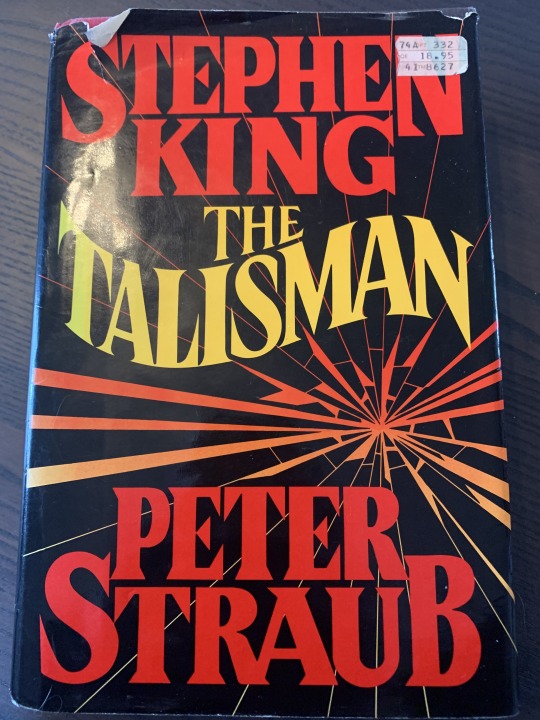
To be clear, I don’t believe social distancing, and the cancelling of the entire world is insane. I’m speaking more to the people with their bunkers full of toilet paper and canned pears; stocking up on ammo, preparing to fight their governments. Just... stop. Color some pictures with your kid. Rake your yards. Have a beer and play Scrabble with your spouse. Crack open a book. Live your damn life without fear of what could happen next week!
Ok, rant over. But seriously, keep washing those hands and social distancing yourselves.
This was my second read of The Talisman, and it remains one of my all-time favorite books. Not just Steve books, but book-books in general. Like with The Stand, I’m going to give the most abridged, bastardized review ever... because there’s just too much to cram into one post. And I’m not ambitious enough to stretch it into two.
Jack Sawyer (fun fact, the names of two of my favorite humans... Jack was my Grandfather, and Sawyer is my daughter) finds himself chilling at The Alhambra Inn and Gardens in New Hampshire with his mother, Queen of the B movies, Lily Sawyer. They’re on the run from the incessantly ringing phone, and constant calls from “Uncle” Morgan Sloat, who was Jack’s dead dad’s business partner. Spoiler: Uncle Morgan is a bad man.
A word about The Alhambra... what initially pulled me into this book was the fact the old, abandoned hotel, beach, boardwalk and amusement park reminded me SO MUCH of Old Orchard Beach, Maine. When Steve (and Pete. I call him Pete) are describing the horses on the carousel, and the rickety old boardwalk, “This is where the world ends, right?”



All the nostalgic feels of summers spend in OOB on the beach. Reading these pages, I could almost feel the crunchy beach towels, smell clam strips and fried dough, taste the cocktails I smuggle into my not-at-all suspicious Yeti mug... ALL THE FEELS!!
And now a word about Lily Sawyer. One of the most memorable details about Lily is her “elementary martini,” which I will now describe for anyone who might need a cocktail during these challenging times. I’m pretending to be a homeschooling mom, so I’m going to take a hard pass. But we have Facetime Cocktail Time with friends tonight, so I might have to have one then.
“Ice in a glass. Olive on ice. Tanqueray gin over olive... Then, you take a bottle of vermouth- any brand- and hold it against the glass. Then you put the vermouth back on the shelf and bring the glass to me.”
Lily is spending a lot of time in bed, avoiding the phone, and fighting some kind of illness, which leaves Jack to his own devices. One day while Jack is out exploring, he makes the acquaintance of one Speedy Parker, the maintenance man at the amusement park. Speedy refers to Jack as, “Travelin’ Jack” which is what Jack’s dad used to call him when he was younger. But it’s more than just a cute nickname, it refers to the fact Jack can travel between our world, and The Territories, a Game of Thrones-esque medieval world. Speedy explains Laura DeLoessian, the Queen of the Territories is dying, and only Jack can save her by rescuing The Talisman. Laura is Lily Sawyer’s doppelganger, and if Jack saves Laura, he can also save his sick mother. Jack’s reluctant, but knows he has no other choice. Speedy hands him a vial of mysterious traveling juice that allows Jack to travel between worlds, and he’s off.
The journey is a long one, and filled with some of the best characters ever, as well as some of the worst baddies. And all their Territories doppelgangers. I’m not going to lie, it’s a lot of people to keep track of. No shade if you need to develop a spreadsheet to keep track of everyone. The OCD freak in me immediately regrets NOT creating a spreadsheet...
My hands-down favorite character (other than Jack Sawyer) is Wolf, a well, Wolf, that Jack meets in The Territories. When they are under attack from Morgan Sloat’s Territories Twin, Jack flips him and Wolf into our world. Wolf does not adjust well. He hates the way everything smells, he can’t be in a confined space, and oh! I forgot to mention... he’s also a werewolf. I’ll talk more about Wolf’s character arch later on when I get to Sunshine Gardener.
Everyone loves an evil character, and The Talisman has no shortage of them. My favorite Talisman baddies included Smokey Updike and Sunshine Gardener,
Smokey owns Updike’s Oatley Tap, and hires Jack to come and work for him. Jack is on the move across the country, and needs some cash in his pocket for food and shoes... because he’s been wearing them out an alarming rate. Walking across the country will do that to you. But the fact Smokey would hire a CHILD to haul beer kegs, and mop up vomit in bathrooms pretty much tells you what kind of winner he really is. To add to his charm, he has Jack sleep on a concrete floor, slaps him around, and deducts room and board from the meager amount he pays him every week. And he threatens Jack with calling the cops and reporting him as a runaway if he tries to leave. Jack can’t have that happen. His evil Uncle Morgan knows he’s flipping between worlds, and doesn’t want Jack to get The Talisman, so he’s in pursuit of his quasi-nephew. Sooo basically Smokey’s got Jack as an indentured servant. He’s charming. One night, Jack can’t take the vomit coated floors anymore, and takes off into the night, with the help of Speedy’s traveling juice. Adios, Oatley!
Sunshine Gardener... there’s a villain who makes Smokey look like someone’s cuddly uncle. Sunshine is a televangelist who also runs Sunlight Home for wayward boys. Sunshine has a sweet deal going: local cops pick up runaway boys, and the judge sentences them to a stay at Sunlight Home. They get paid under the table for adding to the flock, and Sunshine gets to write it off on his taxes every year. Or something like that. He’s obsessed with Jack, and swears they’ve met before (they have. In The Territories. But Jack isn’t about to tell him that). He (and his little band of assholes) proceed to torture Jack, and try to get the truth out of him. Jack resists. Eventually, he and Wolf are caught in the bathrooms, trying to flip over to The Territories. They put Wolf in a coffin-like box in the backyard, where he eventually transforms into a werewolf and kills (almost) everyone in a bloody rage, before he’s shot. I’m not ashamed to admit I cried as Wolf died in Jack’s arms, telling him, “I...kept...my...herd...safe...”
Yep, I’m bawling all over again. The concept of keeping the herd safe is so important right now. I want to kill these asshole kids on spring break, wanting to live their best life ever. Stop it, you entitled little bitches! Help to keep your herd safe! Social distancing won’t kill you! As my little family is tucked in with a refrigerator and freezer full of food, board games and books on the shelves, and a full wine cellar, all I can think about is keeping my herd safe. Ain’t nothing bringing me out of my house! Except my asshole beagle, who needs two walks a day, to prevent her from eating my dresser.
Ultimately, Jack outsmarts his Uncle Morgan, gets The Talisman, this glowing ball of light from The Black Hotel; all the baddies get theirs, and Jack heals both his mother and Laura. And they all live happily ever after. Well, until Black House. But that’s a long ways off.
The entire book is brilliant, and exactly the escape I needed. Steve and Pete are a lethal combination; they successfully weave together horror and fantasy, making you feel Jack’s struggle as if it were your own. You can tell they’re both students of the great Ray Bradbury, they write about the echos between worlds, which mirrored A Sound of Thunder. “...it suggested that just by being over here he could be doing something terrible in the other world. Starting World War III? No, probably not. He hadn’t assassinated any kings lately, young or old. But how much had it taken to set up the echo?”
Also, their author photo cracks me up. It looks like an IBM promotional shot from the 1980′s or something.
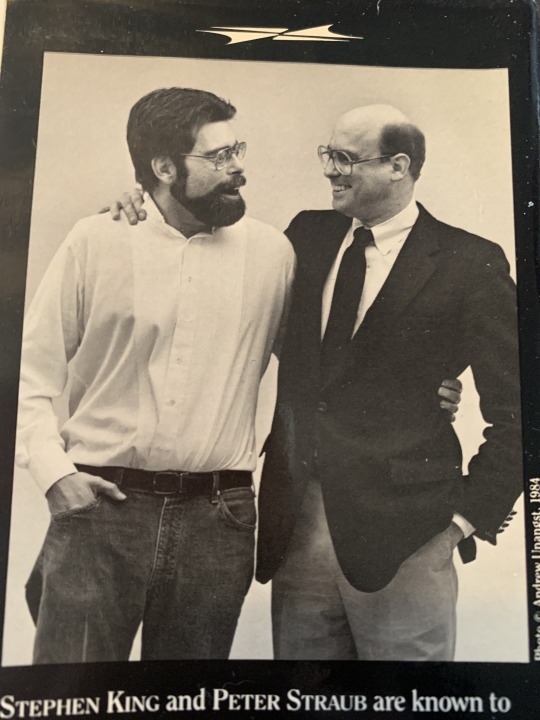
There were no Wisconsin references, but the book was one, big, underlying Dark Tower reference. There was talk of trains (Blaine, y’all!). Jake and his friend Richard refer to each other as chums (lobstrosities... shudder!). A building named Rainbird Towers collapses (collapsing towers. Duh). I can’t wait to get to the other books in the series.
Total Wisconsin Mentions: 14
Total Dark Tower References: 10
Book Grade: A+
Rebecca’s Definitive Ranking of Stephen King Books
The Talisman: A+
Different Seasons: A+
The Shining: A-
The Stand: A-
The Dead Zone: B+
‘Salem’s Lot: B+
Carrie: B+
Creepshow: B+
Cycle of the Werewolf: B-
Danse Macabre: B-
The Gunslinger: C+
Pet Sematary: C+
Firestarter: C+
Cujo: C-
Nightshift: C-
Christine: D
Next up is Skeleton Crew. We all know how I feel about short stories, but it might be a nice palate cleanser after the denseness (is that a word? Spellcheck didn’t flag it, so we’re going to go with YES) that was The Talisman.
Long Days & Pleasant Nights, Rebecca
#the talisman#stephen king#constant readers#peter straub#coronavirus#dark tower#black house#escape reads
2 notes
·
View notes
Text

The Smith House or Sidman’s Tavern along Route 17 in the Ramapo Pass is an important New York and Sloatsburg historical asset that also has a plot of pre-Revolutionary War Cemetery and last vestiges of the Clove Road, or Revolutionary War Highway. Photo Credit: SloatsburgVillage.com
http://www.sloatsburgvillage.com/sloatsburgs-original-watering-hole/
It was mid-May, 2018, when the chainsaws bit the air in a flurry of activity at the site fast-becoming Ramapo Woodmont Apartments. The massive apartment development along Route 17 just south of Sloatsburg, NY, is located at the former, longtime home base of the Ramapo Land Company, and, as an historical note, is the last bit of a land tract that dates back to the very beginning of what is now Sloatsburg.

Photo by Aiden Hand, 2019
Trees were cleared, earth was moved and the huge excavated area, which for many years was sloping woodland and nearly hidden from view, was suddenly exposed brown dirt, complete with those familiar Rockland County boulders.
The Town of Ramapo Planning Board approved Woodmont in 2014, the waning days of Christopher St. Lawrence long run as town supervisor. The Village of Sloatsburg battled the development throughout the planning board process and, even after approval, into Supreme Court in Rockland County. The Village lost an Article 78 decision in 2015 but was able to stall the proposed project until construction finally broke ground.

Photo by Aiden Hand, 2019
Where Sloatsburg Started
With the removal of the thick tree coverage, the old white Smith House has been left standing like some lonely sentinel left over from a bygone era. It is known more recently as the former home of the Pierson Mapes family. But it’s history goes way back to the very beginnings of what would become Sloatsburg.
Before Stephen Sloat married Martha Van Dusen and built the Sloat House in or around 1753-55, there was the Van Dusen Tavern. Built by Issac Van Dusen possibly around 1714, the origins of the old house and tavern remain in the foundation stones, timbers and walls of the Smith House, or as it was widely known in its time — Sidman’s Tavern.

Part of Ramapo’s 2014 Planning Board agreement with Woodmont Properties, the New Jersey developer building Ramapo Woodmont, calls for the dedication to the Town of the Smith House (historically known as Sidman’s Tavern), a pre-Revolutionary War Cemetery next door and the last vestiges of the old Clove Road or Albany Highway. The Clove Road ran north/south to the west of the Smith House and parallel to what is now Route 17.
The Albany Post Road was the Colonial and Revolutionary War north/south land route from lower New York to Albany. The road followed the Ramapo River Valley through the Ramapo Mountains. The Ramapo Pass, also known at the Clove (from the Dutch kloof, which means chasm or gap), was strategically defendable at the bottleneck in Hillburn, NY.
During the pre and post Revolutionary War period, the Albany Highway was a main route and circled from the Hudson River through these parts and then north, curling to Albany. People riding through the Clove Road only had a few public houses to spend a safe night.
Taken together, these historical assets provide the origination story of Sloatsburg.
The dedication to the Town has put Ramapo and Woodmont into a predicament as Ramapo has been trying to reduce it’s historical property portfolio, leaving Woodmont in a sort of limbo about what to do with the Smith House/Sidman’s Tavern.
Woodmont Properties General Counsel Stephen Santola has said that Woodmont intends to preserve the Revolutionary War Cemetery. The Woodmont plans also calls for an historical marker to acknowledge the Albany Highway/Clove Road — with eventual input and oversight of the project by the Town of Ramapo Historian (currently Craig Long).
But both Ramapo and Woodmont are uncertain just what to do with the dilapidated Sidman’s Tavern, which has stood empty now for nearly 20 years.
The Historical Society of Rockland County and a contingent of Sloatsburgers prefer that the house be preserved and rehabilitated. Taken together the house, cemetery and vestiges of New York’s original highway provide a unique trifecta of historical assets for this area — and imbue the Ramapo Woodmont Apartments with a certain significance. Some wonder why the house can’t be restored during the building phase of Woodmont and then used by the property as a sort of public space.
Sloatsburg’s Original Land Grant: The Ramapo Clove
According to historical records documented by Corridor Through the Mountain by Richard Koke (written for the Orange County Historical Society), Isaac Van Deusen (also spelled Van Deursen and/or Van Duzen) came to the Ramapo Clove in 1724 with his father and settled on land purchased from the local Indians by John Van Blarcum. Clove is a Dutch word for a narrow valley with steep hills surrounding it.
Van Deusen land in the Ramapo Pass consisted of two main tracts that, together, shaped the Ramapo Valley and Sloatsburg. The northern “Pothat” tract was purchased from local Indians in 1738 by Dutch settler and Isaac Van Deusen brother-in-law, Wynant Van Gelder, and the southern tract, purchased from Van Blarcum.

Part of the original stone and timber foundation of Sidman’s Tavern which could date back to the early 1700s.
In 1747, Van Gelder deeded the Pothat tract to Van Deusen and it was this tract that was deeded to Stephen Sloat in 1763 when he married Marretje Van Deusen, daughter of Isaac Van Deusen — the marriage apparently took place in the mid 1750s. These Sloat lands eventually became the Village of Sloatsburg and ranged from the current boundary line of Sloatsburg at the Orange/Rockland County line in the north to the Sloatsburg village line in the south near Auntie El’s. The tract ran from where the New York Thruway now snakes all the way west to Sterling Mine Road, and had the Ramapo River running through the middle.

Excerpt from Richard J. Koke’s Corridor Through the Mountains (see full link below)
Smith’s Clove: Wartime Line of Communication and Passageway for the Continental Army, 1776-1783. Published and copyrighted by the Orange County Historical Society.
English born Samuel Sidman entered the Ramapo Clove in 1746 and shortly thereafter married Isaak Van Deusen’s daughter Angneitje Van Deusen — making Stephen Sloat his eventual brother-in-law. Stephen Sloat went on to build Sloat’s Tavern, probably in the 1750s — the rear part still stands as part of the Sloat House & Inn and the entire house is listed on the National Register of Historic Places.
Sidman’s wife Angneitje Van Deusen was born at her father’s tavern in 1724 — which would make the Smith House or Sidman’s Tavern the oldest commercial and residential structure in these parts, and one of the oldest in Ramapo. Sidman and Angneitic inherited the tavern and lands south of the Pothat/Sloat tract in the Ramapo Valley which included all the land that is now known as Torne Valley.

A cemetery stone found at the Revolutionary War Cemetery next to Sidman’s Tavern or the Smith House at the current Ramapo Woodmont Apartment development.
Both Sidman’s Tavern and Sloat’s Tavern, a mere mile north of Sidman’s, were two of the original seven Revolutionary War taverns above the New Jersey line on the Clove Road, that also included John Suffern’s Tavern.
Of the seven original taverns along the Clove Road, Sidman’s and the Sloat Tavern (now known as the Sloat House & Inn) may be the sole remaining structures from the pre-Revolutionary War period.
Sidman and John Suffern were signatures in 1775 of the General Association which pledged support of the Continental Congress.
The cemetery beside Sidman’s Tavern dates to before the American Revolution and is the known burial plot for the Van Deuser family, including Samuel Sidman who died in late 1777 or 1778. Significantly, the cemetery beside Sidman’s Tavern was likely used to bury members of the Colonial army who died while guarding the Ramapo Pass.
Woodmont and Ramapo and Historical Preservation

A photograph of the old Clove Road, a remnant of the original New York and Albany Post Road, also known as the Revolutionary War Highway, which ran through Rockland County and, significantly, the Village of Sloatsburg. Parts of Clove Road road in this area of Orange and Rockland Counties eventually became Orange Turnpike/Route 17.
To date, the fate of the Smith House is undecided. Woodmont awaits Ramapo’s direction and Ramapo possibly awaits whether preservation is worth the effort.
The Smith House at Ramapo Woodmont is part of the story of Sloatsburg. As importantly, the three assets are nationally significant and their preservation would celebrate the character and culture of the Village of Sloatsburg, Hudson Valley and New York State, especially as the nation prepares to mark the 250th anniversary of the American Revolution.

#rockland history#local history#rockland county#rocklandhistory#nyshistory#historic preservation#sidwell tavern#sloatsburg#ramapo#rescue
1 note
·
View note
Text
Horror at the 9/11 attacks contributed to peace in Northern Ireland
New Post has been published on http://khalilhumam.com/horror-at-the-9-11-attacks-contributed-to-peace-in-northern-ireland/
Horror at the 9/11 attacks contributed to peace in Northern Ireland

By Amanda Sloat Like many Americans, I marked the anniversary of the September 11, 2001 terrorist attacks by remembering where I was on that terrible day. My memories are indelibly intertwined with Northern Ireland, where I had just arrived as a post-doctoral research fellow. My new boss insisted that I come to her house, where I watched news reports, called family and friends, and slept in a borrowed nightgown. It was the first of many kindnesses from people who knew firsthand the scourge of terrorism, as they had lived through decades of sectarian violence known as the “Troubles” that resulted in over 3,600 deaths. Three days later, U.S. Consul General Barbara Stephenson spoke at a memorial service outside Belfast city hall. Flanked on stage by political and religious leaders from Protestant and Catholic communities, she said: “The best thing you can do to help us is find peace amongst yourselves.” Afterwards, a taxi driver took me on a tour of the city, where I saw burn marks on houses from petrol bombs, so-called “peace walls” separating communities, curbstones painted in the colors of the British flag, and murals celebrating freedom fighters around the world. At that time, British and Irish officials were working to implement the Good Friday Agreement. The deal had been brokered three years earlier by George Mitchell, President Bill Clinton’s envoy for Northern Ireland, who brought together the Protestant and predominantly unionist community with the Catholic and largely nationalist one. A power-sharing executive gave both communities a voice in decisionmaking, the British government removed security checkpoints from the border, and paramilitary groups pledged to decommission their weapons. The European Union (EU) membership of Britain and Ireland enabled the removal of additional barriers. Slow progress on decommissioning weapons hindered the agreement’s early years, with unionist leaders concerned about the arsenal of the Irish Republican Army (IRA) — a paramilitary organization opposed to British rule in Northern Ireland. On the morning of September 11, 2001, Richard Haass, President George W. Bush’s envoy for Northern Ireland, met in Dublin with Gerry Adams, the leader of Sinn Féin, a nationalist political party with links to the IRA. Haass was upset about the recent arrests in Colombia of three suspected IRA veterans who were accused of providing explosives training to the Revolutionary Armed Forces of Colombia (FARC), a leftist guerrilla organization seeking to topple the government in addition to trafficking cocaine into the United States. Haass reportedly questioned the IRA’s commitment to the peace process and warned that American engagement with Sinn Féin (including the provision of travel visas to the party’s leaders) could be jeopardized if FARC attacks conducted with IRA equipment harmed U.S. personnel. Haass’ case was bolstered by the 9/11 attacks, which altered the Western world’s perception of terrorism and led many benefactors — including Irish-Americans who had long provided financial backing to Sinn Féin and Irish paramilitary groups — to rethink their support. The combination of American diplomacy and diaspora influence, in concert with ongoing efforts by the British and Irish governments, led to the IRA’s historic announcement on October 23, 2001 that it had begun decommissioning its weapons. Although the power-sharing government proceeded in fits and starts, the peace process was finally on the right trajectory. Politicians began addressing mundane issues of governance rather than contentious issues of identity. Foreign direct investment increased, with nearly 900 international companies employing around 100,000 people. Belfast, which was named the best travel destination in 2018 by Lonely Planet, opened a museum about the locally-constructed Titanic, served as a filming location for “Game of Thrones,” and attracted trendy boutiques and cafes. This positive momentum stalled in the wake of Brexit. In June 2016, the U.K. opted by a narrow margin in a June 2016 referendum to leave the EU; notably, 56% of voters in Northern Ireland preferred to remain in the EU. Although the region was rarely discussed during the campaign, disagreements between London and Brussels about the post-Brexit management of the Irish border plagued divorce negotiations. They also reopened old wounds in Northern Ireland, prompting debate about constitutional arrangements and hindering efforts to resuscitate the Northern Ireland Assembly, which collapsed after a breakdown in trust and left the region without a political voice for three years. After extensive debates about a “backstop,” the two sides ultimately agreed on the “Northern Ireland Protocol” and concluded the deal. After the U.K. left the EU on January 31, the sides began negotiating their future relationship, including thorny trade relations. The talks, whose logistics were hampered by the coronavirus pandemic, faltered over competing visions of economic competition rules and the complexities of managing customs and tariffs on goods traveling between Northern Ireland and the Republic of Ireland. This week, the British government introduced legislation threatening to undo key provisions of the protocol. Although the British government claims these changes will protect the Good Friday agreement, the EU fears they will do the opposite. For decades, there was a bipartisan consensus in Washington about the importance of facilitating and preserving peace in Northern Ireland. The Trump administration has not made any public statements on the draft legislation, although officials are reportedly having quiet conversations. (Despite talking points that support the Good Friday Agreement, the administration’s credibility has been hindered by the president’s enthusiasm for Brexit at any cost.) In contrast, congressional Democrats have consistently expressed American support for the peace process throughout the Brexit process. In separate statements this week, House Speaker Nancy Pelosi, Ways and Means Chairman Richard Neal, and Foreign Affairs Chairman Elliot Engel warned that the proposed changes could hinder a future U.S.-U.K. trade deal. Similarly, Tony Blinken, a key advisor to Joe Biden, tweeted the candidate’s desire to see the Good Friday Agreement protected during the negotiations. As Americans mark the 19th anniversary of September 11, it is worth remembering how that tragic day helped bolster the faltering peace process in Northern Ireland. As Irish and British leaders observed years later, the tragedy created a moment of opportunity by changing the political context and perceptions of terrorism, which led the IRA to decommission. As one local religious leader noted: “We here in Ireland are perhaps the only beneficiaries of 9/11.” That hard-earned peace should not be squandered, by Britain or the United States.








0 notes
Text
The Talisman- co-written w/ Peter Straub 1984
What is it about? Jack Sawyer, a 12 year old boy begins his quest for the Talisman- the only thing in the world that could save his mother’s life- after meeting Speedy Parker, and rediscovering the Territories (a place he used to day dream about in his childhood) while Morgan Sloat, a bussines man and Jack’s dead father bussines partner attempts to stop him.
Thoughts:
- I confess I have never read a Peter Straub’s book but now I might because this colaboration with Stephen King was amazing.
-A truly epic adventure, Jack is the kind of hero you can’t help but root for, what makes even harder to read all the misfortunes he meets along the way, for real sometimes I just had to close the book and do something else because it was too upsetting (Oatley Tap and the Sunlight Home specially).
-It made me think about the Dark Tower a lot, don’t know if they are connected in any form of way yet (and I don’t want spoilersof that’s the case) but the black hotel, and all the multiple universes connected through the Talisman sound a lot like the Dark Tower stuff I read on the Gunslinger.
-The villans are truly terrible, Osmond seems the most evil at first but Sloat is truly disgusting, his PoV’s are awful he is literally the Worst.
-Wolf will be always be in my heart.
-Loved the Territories vs. The American Territories. The places, people, the Twinners… basically all the lore is fascinating.
TV/Movie Adaptations: Sadly there are none :(
Quotes:
“He began to cry, not hysterically or screaming as people cry when concealed rage with tears, but with continuous sobs who has just discovered that he’s alone and will be for long. He cried because safety and reason seemed to have left the world. Loneliness was a reality, but in this situation madness was also remotely a possibility.”
“Everything goes away, Jack Sawyer, like the moon. Everything comes back, like the moon.”
“You don’t own a thing unless you can give it up, what does it profit a man, it profits him nothing, it profits him zilch, and you don’t learn that in school, you learn it on the road, you learn it from Ferd Janklow, and Wolf, and Richard going head-first into the rocks like a Titan II that didn’t fire off right.”
“…he never forgot that sweet, violent feeling of having touched some great adventure, of having looked for a moment at some beautiful white light that was, in fact, every color of the rainbow.”
"He could not say goodbye to these three rooms as he could to a house he had loved: hotel rooms accepted departures emotionlessly.”
Next Book: IT
7 notes
·
View notes
Photo

Dogs and Men Share a Big Fertility Problem Linked to Household Chemicals
"The dog, therefore, seems to mirror what we see in the human."
Sarah Sloat
March 4, 2019
Things are not going so great for man: Over the last 80 years, human sperm quality has declined by half. And the sperm of man’s best friend isn’t doing so hot, either, with studies showing their sperm motility has declined by over 30 percent throughout the last 26 years. Now, a study published Monday in Scientific Reports links these seminal events, revealing that environmental contaminants are at least in part to blame.
Scientists from the University of Nottingham determined that two man-made chemicals affect the quality of both human and dog sperm: one called DEHP and the other industrial chemical polychlorinated biphenyl 153 (PCB153).
The former, added to make plastics flexible, is widely abundant in household items as diverse as carpets and toys. PCB153, meanwhile, has been used in plasticizers, surface coatings, and paints. It’s now banned globally, but it remains widely detectable in the environment, say the researchers. Notably, both chemicals have been detected in commercially available dog food.
Co-author Richard Lea, Ph.D., an associate professor of reproductive biology at the University of Nottingham’s School of Veterinary Medicine and Science, tells Inverse that he and his team previously determined it’s the dogs who share our homes that have suffered a decline in sperm. This led them to hypothesize that the chemical pollutants in our homes and general environments could be the cause.
“The dog, therefore, seems to mirror what we see in the human and, a bit like a ‘canary in the coal mine,’ provides a way of monitoring chemical effects in humans,” Lea explains. “It was important to test this idea by looking at the effects of the two chemicals on sperm. This study has demonstrated similar effects in both man and dog.”
To test the hypothesis, they collected nine samples of human semen and 11 samples of dog semen, and then incubated them in a lab together with PCB153 and DEHP. They applied these chemicals in concentrations previously detected in sperm from dogs undergoing routine reproductive assessments, the idea being that the amount used would mimic the amount naturally encountered in a home.
Sure enough, the chemicals reduced sperm motility and increased DNA fragmentation in both the dog and human samples. Scientists have previously established that when human sperm motility is poor, DNA fragmentation increases, influencing the likelihood of male infertility.
Now, Lea says, the natural next questions to ask are how these chemicals affect females and how geography affects chemicals in sperm and sperm quality. The study posits that, because these environmental pollutants are a large part of Western industries, it’s possible that location determines the extent to which males are affected. Other studies have pointed out that the so-called world sperm decline hasn’t been seen among those living in Asia, Africa, or South America, lending support to the idea that it may be a predominantly Western problem.
Chemical pollutants may not be the only factors driving the downfall of sperm. Other studies have argued that factors like air pollution and obesity could also be to blame, but the shared impact on dogs and humans adds to the idea that human-made chemicals can disrupt the chemical messenger system controlling hormones. Pet dogs and humans live in the same domestic environment, so it’s reasonable to say the same exposure to household contaminants affects their sperm.
“Demonstrating such effects of chemicals at environmental concentrations raises awareness of these pollutants,” Lea says, “and my hope is this will lead to steps in our personal lives to reduce or at least limit further exposures.”
0 notes
Text
New fic just dropped. If you've read the Talisman please read it cause I'm sad.
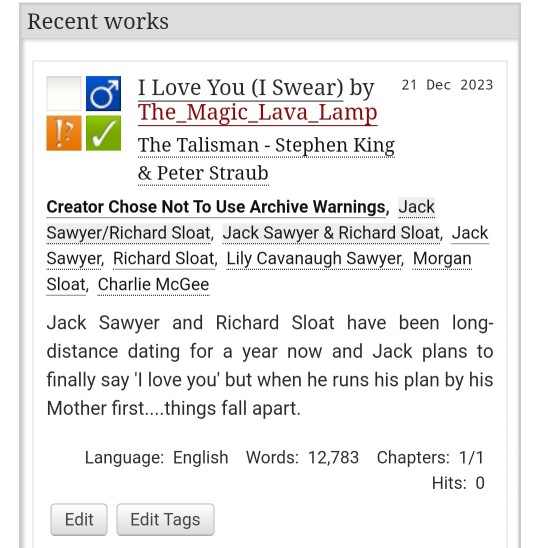
#the talisman#stephen king#peter straub#richard sloat#Jack Sawyer#my fanfiction#fanfiction#writing#ao3#archive of our own#gay
19 notes
·
View notes
Note
I know you've read a lot of King, do you have any ships?
I do actually! For some reason I don’t post a lot about my ships on here but I have quite a bit lol. I’ll list all of my SK ships
In no particular order:
Dennis Guilder/ Arnie Cunningham- Christine
Ray Garraty/ Peter McVries- The Long Walk
Gordie LaChance/ Chris Chambers- The Body/ Stand My Me
Eddie Kaspbrak/ Richie Tozier- IT
Jonesy/ Beaver Clarendon- Dreamcatcher
Henry Devlin/ Pete Moore- Dreamcatcher
Tom McCourt/ Clayton Riddell- Cell
Clayton Blaisdell/ Johnny Cheltzman- Blaze
Jake Chambers/ Benny Slightman- Wolves of the Calla
Roland Deschain/ Cuthbert Allgood- The Dark Tower
Jack Sawyer/ Richard Sloat- The Talisman
Alan Pangborn/ Polly Chalmers- Needful Things
Eddie Dean/ Susannah Dean- The Dark Tower
Sue Snell/ Carrie White- Carrie
Ben Hanscom/ Beverly Marsh- IT
Bill Denbrough/ Mike Hanlon
Stu Redman/ Frannie Goldsmith- The Stand
Don Callahan/ Lupe Delgado- The Dark Tower
Dayna Jurgens/ Susan Stern- The Stand
Thank you for asking!
#stephen king#stephen king ships#stephen king fans#stephen king books#stephen king movies#it by stephen king#the losers club#reddie#it 2019#it 2017#the stand#stephen kings the stand#the dark tower#the dark tower series#stephen kings dreamcatcher#the long walk
31 notes
·
View notes
Text
PAL JOEY
1989

Pal Joey is a musical with a book by John O'Hara and music and lyrics by Richard Rodgers and Lorenz Hart. The musical is based on a character and situations O'Hara created in a series of short stories published in The New Yorker, which he later published in novel form.
The title character, Joey Evans, is a manipulative small-time nightclub performer whose ambitions lead him into an affair with the wealthy, middle-aged and married Vera Simpson.

Directed by George Abbott, the musical opened on Broadway on Christmas Day 1940, at the Ethel Barrymore Theatre and ran for 374 performances. The cast included Gene Kelly as Joey, Vivienne Segal as Vera, and June Havoc as Gladys. Van Johnson and Stanley Donen were also in the cast.
Throughout much of the 1940s, the songs from Pal Joey were banned from radio play by ASCAP, preventing them from becoming popular standards. But in "Bewitched, Bothered and Bewildered" was covered by many artists and it became a hit, inspiring a concept album and a Broadway revival in 1952 starring Harold Lang as Joey, and a young Elaine Stritch as Melba. This production out-ran the original clocking in at 540 performances. Two years later the musical was in the West End.
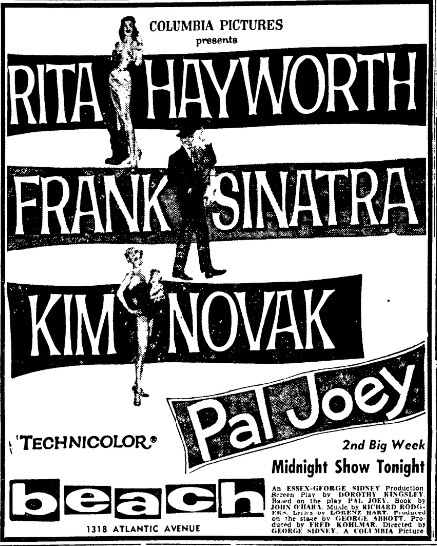
In 1957 a film adaption appeared starring Frank Sinatra, Kim Novak, and Rita Hayworth.
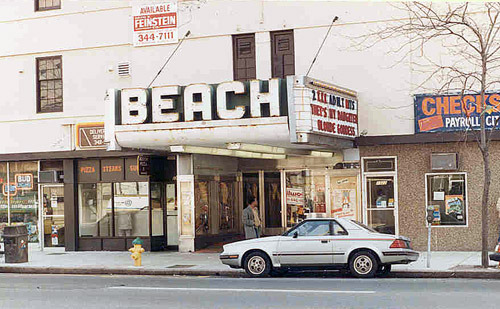
In December 1957 Joey was in Atlantic City at at last - albeit on screen at the Beach Theatre on Atlantic Avenue. In the years ahead, the theatre went from first run films to porn before being damaged by fire and closed. Although no longer a cinema, the building (sans marquee) is still intact today. But back to Joey...
Bob Fosse headlined a 1963 City Center Revival, earning himself a Tony nomination. A second Broadway revival in 1976 starred Christopher Chadman as Joey and lasted just two months at Circle-in-the-Square. An all-black version titled Pal Joey ‘78 was even less successful on the road and soon shuttered. In 2008, a substantially re-written production briefly returned to Broadway. Produced by Roundabout, it starred Matthew Risch (taking over for an injured Christian Hoff), Stockard Channing, and Martha Plimpton.
By 1940, Atlantic City was no longer an out-of-town tryout destination. With theatrical venues converted to cinemas or burlesque houses, there was no shelter by the sea to birth new shows. Instead, the honors went to to cities closer to the Main Stem like New Haven, Hartford, and Boston. In her one-woman show At Liberty, Elaine Stritch talks (and sings) about her experiences out-of-town in New Haven with Joey, while simultaneously understudying Merman in Manhattan.
youtube
Fast Forward to 1989, Pal Joey finally plays Atlantic City in a tab (90-minute) production at the Palace Theatre in the historic Claridge Casino-Hotel.
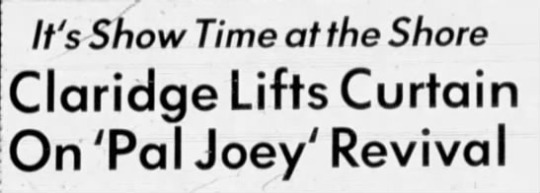
The show was produced by Maynard Sloate, directed by Jack Bunch, and choreographed by Jack Payne starring Clint Holmes as Joey, Barbara Henson as Vera, and Trish Gorman as Linda. It opened on April 11, 1989. The cast also included Scott Jarvis, Randy Riegelman, and Trish Dowd, to name a few.
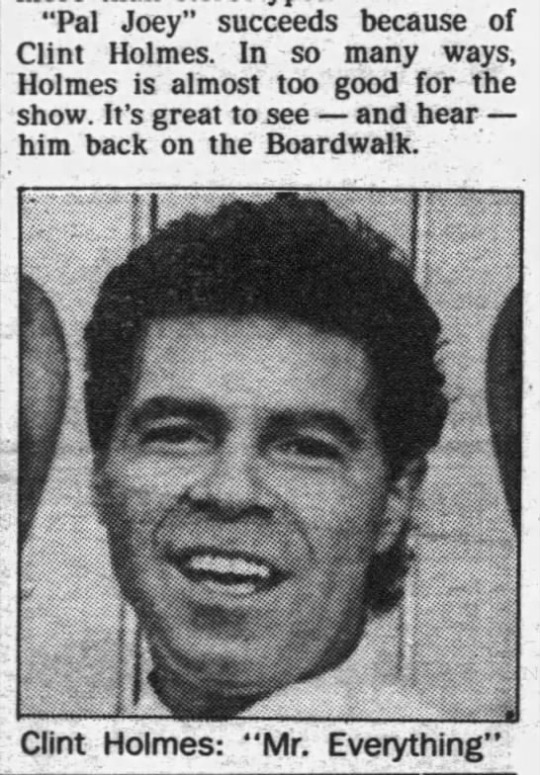
Most critics praised Holmes, especially for his vocal prowess. But not all thought he was able to overcome a partial Pal.

“Because Sloate and Bunch used a chainsaw rather than a scalpel to make the show conform to its casino-mandated 90-minute running time, the coherent story was replaced by a series of out-of-kilter vignettes separated by unsatisfactory renditions of some of Rodgers and Hart's greatest hits.” ~ CHUCK DARROW, COURIER-POST
The production was schedule to run through June 25, but was extended to September 3, 1989.

The extension, however, did not feature Clint Holmes. He was replaced by Tony Darrow. Sadly, he was welcomed with more jeers than cheers.

“The Claridge's version of 'Pal Joey' is too depressing to ponder.”
“Rodgers and Hart's 'Pal Joey' is a classic, and the Maynard Sloate production of 'Pal Joey,' at the Claridge's Palace Theater through Sept. 3, is a disaster.”
When it comes to tab prods, Alvin Klein of the New York Times preferred Pudgy in Nunsense (playing at nearby casino showroom) to Pal Darrow.

Like Holmes, Darrow was an Atlantic City favorite, performing on club stages regularly. He is probably best known for his mob roles on screen, especially the New Jersey-set “Sopranos”. In 2011, fiction met fact when was charged with extortion and sentenced to six months house arrest.
Clint Holmes left AC for LV, becoming so popular in Vegas that they named a theatre after him. In 1996, Holmes returned to New Jersey to premiere his biographical musical Comfortable Shoes at Paper Mill Playhouse in Millburn. In September 2021, Holmes was back in Atlantic City performing to sold out crowds at Harrah’s.
#Pal Joey#Atlantic City#Clint Holmes#Tony Darrow#Claridge#1989#Broadway Musical#Musical#Theatre#Stage
0 notes
Photo

Richard Sloat. American Zion (1992, 2015)
9 notes
·
View notes
Text
Zuora, Inc. (ZUO) CEO Tien Tzuo on Q3 2020 Results - Earnings Call Transcript
Zuora, Inc. (ZUO) CEO Tien Tzuo on Q3 2020 Results �� Earnings Call Transcript
Zuora, Inc. (NYSE:ZUO) Q3 2020 Earnings Conference Call December 5, 2019 5:00 PM ET
Company Participants
Joon Huh – VP, IR
Tien Tzuo – CEO
Tyler Sloat – CFO
Conference Call Participants
Richard Davis – Canaccord
Luv Sodha – Jefferies
Chris Merwin – Goldman Sachs
Operator
Ladies and gentlemen, thank you for standing by and welcome to the Zuora Third Quarter Fiscal 2020 Earnings Conference…
View On WordPress
0 notes
Link
Tracklist
About My Life by Formerly Fat Harry No Expectations by Rolling Stones Kiss The World Goodbye by Kris Krisofferson I Think I Just Want to Go Home by Tiny Lights Frozen Ducks by Furtips Black And White Photographs by Refrigerator Savannah by Azalia Snail Listen by Eric's Trip Soap by Fly Ashtray Calvin Johnson Has Saved Rock For An Entire Generation by The Azusa Plane Never by Useless Wing Mud Order by Donald McPherson Saw-Horse by The Goslings Everclear by Junket Reverence by Crimony M31 by Wingtip Sloat 5 V Envelope by Mote Remember This Series by Telegraph Series No Song To Sing by Michael Chapman When The Bottom Fell Out by Vic Chesnutt Sad Eyed Lady Of The Lowlands by Bob Dylan Love Will Be The Answer by Watchpocket Oxygen by Gary Higgins Blues Stay Away From Me by Merle Haggard R.K. by Rein Sanction Rats And Insects by Menthols Grumbler by Ed Hall Lumber by Xerobot Lost 9-6 by The Scissor Girls Vertical Slum by Rake Lewis by Bugskull Stalled On The Tracks by Smog Velvet Night by Duppi Bad Dream/Hartford's Beat Suite by Magik Markers Secrets by The Cure Palms To Tell by Pillars And Tongues Janet Says by Simon Joyner And The Fallen Men Cry Baby Cry by Hollins And Starr Don't Let It Get You Down by Shadrack Chameleon If I Knew You Were The One by Richard Twice There But Not There by Flying Saucer Attack Nerve Language by Axolotl Change In The Ocean by Shana Cleveland And The Sandcastles Sleezy by Zeena Parkins Deeper Than Inside by Rites Of Spring
0 notes
